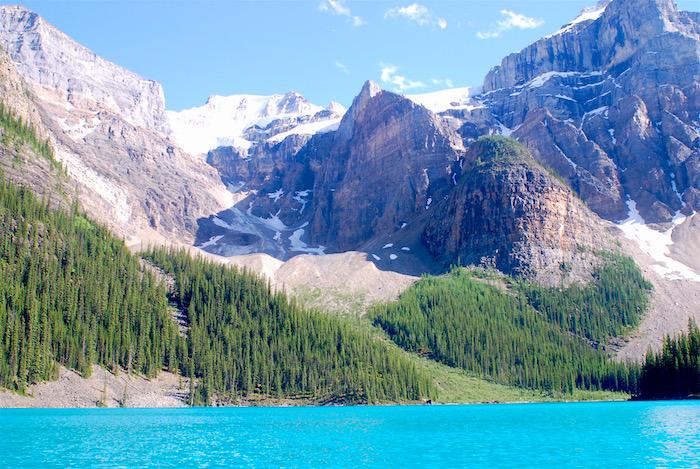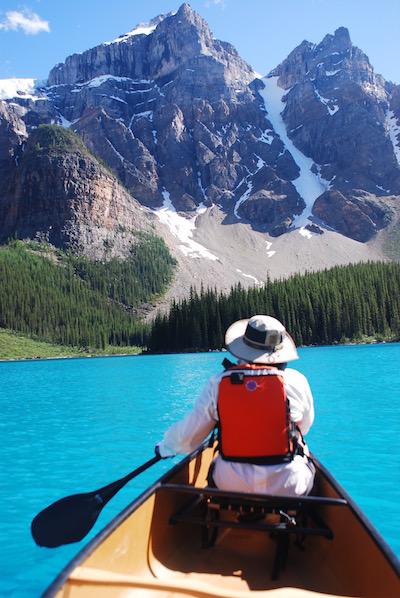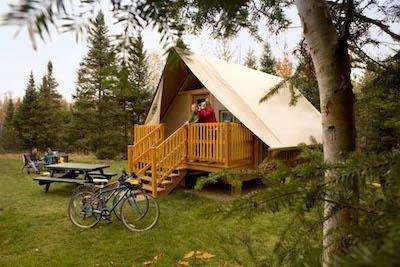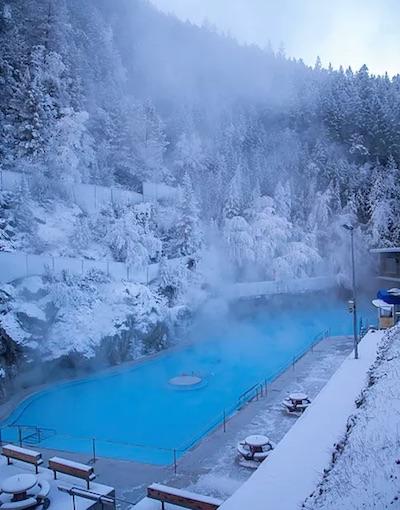In the heart of the Canadian Rockies, a trail gently climbs through a forest, rises above tree line to a meadow dotted with colorful wildflowers, and ascends to a sweeping view of the Columbia Icefield. Here, a pair of brilliant-red Adirondack chairs, placed on the mountain ridge by Parks Canada, beckon. Take a seat and contemplate the scene.
Across the valley, a wall of ice and mountains dominates the horizon, with Athabasca and Dome glaciers pouring over their shoulders. Between the two, a triangle-shaped patch of forest is home to 700-year-old trees. And atop 11,339-foot Snow Dome, the carpet of snow eventually drains to three different oceans – the Arctic, the Pacific, and the Atlantic.
Looking up the trail, a herd of bighorn sheep grazes in an alpine meadow. Beyond, the path traverses a route that 19th century explorer Walter Wilcox negotiated to bypass a treacherous canyon. And down below, one of the world’s most breathtaking roads, the Icefields Parkway, connects Banff and Jasper national parks. Thousands of tourists flock daily to the Columbia Icefield Glacier Discovery Centre to stretch their legs, grab some food, or arrange a tour for an up-close look at (and perhaps even to walk on) a glacier.
But this viewpoint only provides a peek at the scenic wonders, spectacular wildlife, and diverse natural and human history waiting to be found across Canada. And this year, a celebration of the country’s 150th anniversary of confederation includes free admission to all Parks Canada sites. That’s 46 national parks, one national urban park, four national marine conservations, and 171 national historic sites – from Point Pelee at Canada’s southern tip on the shore of Lake Erie all the way to the polar desert of Quttinirpaaq, near the top of the world.
Of course, “free” tends to draw a crowd, particularly with outlets like the New York Times and National Geographic lauding Canada as a top travel destination for 2017. Demand for the free Discovery Passes that grant entry to Parks Canada locations has been “beyond expectations,” said Eric Magnan, a travel media relations officer with the agency. So if your summer getaway plans include dipping your toes in Lake Louise, it isn’t too early to start making an itinerary and booking accommodations.
Reservations for campgrounds opened in January, three months earlier than normal, which means the best spots might already be taken for the most desirable dates, like holiday weekends. In particular, oTENTik sites, tent/cabin hybrids that are available at some campgrounds, have proven popular with families and groups.
“As visitation levels increase and Parks Canada welcomes more people to our national parks, we are encouraging shoulder season visitation and promoting less-frequented and less-sensitive areas of our parks,” Mr. Magnan said.

Glacial ramparts can be seen in most directions of Parks Canada’s realm in the Canadian Rockies / Kurt Repanshek
Of the 14.5 million visitors to Canada’s national parks in 2014-15, nearly 60 percent went to the seven Rocky Mountain parks, with 6 million visitors to Banff and Jasper alone. Another 2.4 million entered Yoho, Kootenay, Mount Revelstroke, Glacier, and Waterton Lakes. So if you prefer a little more breathing room and a little less traffic, look beyond the Rockies or target a visit in the fall or winter. If you can’t resist the jagged peaks and brilliant blue lakes that adorn magazine covers and travel guides, nearby locations like Rocky Mountain House National Historic Site and Elk Island National Park can augment a trip to Alberta. And several provincial parks such as Mount Robson and Wells Gray offer world-class wilderness escapes.
In the U.S., national parks saw record visitation last year as the National Park Service celebrated its 100th birthday – and that was without free admission. So Parks Canada plans to staff up in anticipation of big crowds, hiring 700 additional workers during the peak season. Investments are also being made in campgrounds, at day-use areas, and on hiking trails. Parks Canada “has increased the number of cleaning and maintenance crews to ensure facilities will be kept in shape and that garbage does not attract wildlife,” Mr. Magnan said.
But even at the most popular parks in the busiest season, some serenity (and an open parking spot) can be found by arriving early or late in the day. Bonus: Wildlife tends to be more active at dawn and dusk.
Once you get to a park, celebrate the country’s nature and history by seeking out one of Parks Canada’s newer traditions: red chairs, like the ones above the Icefields Parkway. Starting in 2014, hundreds of these eye-popping Adirondacks were placed at stunning viewpoints, around lakes, and at the end of hiking trails as a way of inspiring visitors to connect with nature.
So pick a park, seek out a red chair, and discover someplace new in Canada.





Comments
I sat in one of those chairs at Bruce Peninsula National Park in Ontario (and saw *lots* of other red chairs all across Canada) last summer.
At the time I wondered why my parks pass was good for two years. Now I know.
I was at Athabaska Glacier back in 1961 or 62. The first photo shows the extent to which the glacier has retreated in the intervening 56 years. Back then, it extended right to the mouth of the valley -- marked by the arm of the chair on the left.